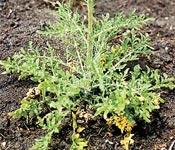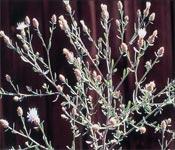Family – Aster Asteraceae
Life Cycle – Biennial or Short Lived Perennial
Habitat -Thrives in semi-arid and arid environments with light porous soils such as gravelly loam, and loamy sands. It is not tolerant of moist soils, flooding or shade.
Key Features
- Stems are upright, highly branched, and angled, with short, stiff hairs on the angles
- Flowers solitary or in clusters of 2-3 at the end of the branches
- Heads contain two types of flowers, ray flowers around the edges surrounding tubular disk flowers
- Unlike other knapweeds the heads of diffuse do not open to the shed seeds
Seedling
Cotyledons are oval with short stalks. The first few true leaves are oblong with an entire margin while later leaves have shallow lobes.
Juvenile
Diffuse knapweed produces an elongated tap root and a rosette of much divided, feathery-looking leaves. In contrast, the leaves of spotted knapweed are deeply lobed into narrow segments. The leaves of both species are covered with a thin layer of matted, woolly hair resembling a cobweb. Stems are erect, much-branched and hairy. Upper stem leaves are bract- like and entire. Although diffuse knapweed is not considered poisonous, it is extremely bitter tasting and generally avoided by grazing animals. Both species of knapweed have almost formed monocultures in rangeland throughout parts of the British Columbia interior. Consequently, a major campaign is underway to minimize their spread into the prairies.
Mature
Numerous narrow heads are produced singly at the ends of branched. The flowers are generally white but occasionally pink-purple. They are surrounded by pale yellowish-green triangular bracts ending in a stiff spine. The involucral bracts are a key way to distinguish diffuse knapweed from its relatives, spotted knapweed and yellow star-thistle. Spotted knapweed heads have bracts with a black-tipped fringe while the bracts on yellow star-thistle heads are modified into slender, sharp spines. The seeds of diffuse knapweed are narrowly oval, light brown-to-black and lack a pappus.
Prevention
Maintain pastures and rangeland as Diffuse knapweed establishes and spreads quickly in disturbed/degraded plant communities. Knapweed contaminated hay or plant skeletons caught in vehicle undercarriages often contribute to the spread. Knapweeds seeds have an extremely hard seed coat and can be viable for at least 5-10 years. Therefore, knapweed control sites will need to be re-visited for many years. Control is extremely difficult on established infestations.
 |
 |
